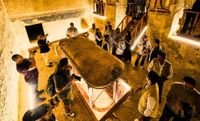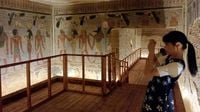After more than two decades behind closed doors, the tomb of Pharaoh Amenhotep III—one of the grandest monuments in Egypt’s Valley of the Kings—has reopened to the public, marking a milestone in both archaeology and cultural tourism. The official ceremony, held on October 4, 2025, in the arid hills west of Luxor, drew dignitaries, archaeologists, and excited visitors eager to witness the results of a restoration project that spanned over 20 years and involved more than 260 international specialists.
The tomb, known as WV22, has long been regarded as a crown jewel of the Eighteenth Dynasty, a period celebrated for its opulence and artistic innovation. Amenhotep III, who ruled Egypt from 1390 to 1350 BCE, presided over an era of unprecedented prosperity and global influence. His reign set the stage for his son Akhenaten’s religious revolution and his grandson Tutankhamun’s legendary legacy. Yet, for all his historical significance, Amenhotep III’s final resting place had remained largely inaccessible for generations—until now.
Originally discovered in 1799 and later rediscovered in 1915 by famed archaeologist Howard Carter, the tomb suffered a fate common to many ancient sites: looting and decay. The king’s sarcophagus and many treasures were removed centuries ago, with only the broken lid—shattered into more than 200 pieces—remaining in situ. Mohamed Ismail Khaled, Secretary-General of the Supreme Council of Antiquities, described the scene to The Associated Press: “Of course, it was unfortunately discovered completely empty, so it was stolen before, even the sarcophagus. Only the lid of the sarcophagus is still there, and it was broken into more than 200 pieces.”
Despite these losses, what endures inside the tomb is nothing short of breathtaking. The 36-meter (118-foot) downward-sloping passageway leads visitors deep beneath the Valley of the Kings, culminating in a main burial chamber for Amenhotep III and adjoining rooms for his Great Royal Wife Tiye and daughter Sitamun. The walls are adorned with vibrant murals—described by the Theban Mapping Project as “among the most exquisite” of the Eighteenth Dynasty—depicting the pharaoh in the company of gods such as Osiris and Ra. Painted in ochre, black, and ultramarine blue, these scenes have survived the ravages of time, offering a rare glimpse into the spiritual beliefs and artistic mastery of ancient Egypt.
The restoration of WV22 was a mammoth undertaking, spearheaded by a Japanese-funded mission in partnership with UNESCO and Egypt’s Supreme Council of Antiquities. Over 260 archaeologists, conservators, and technicians participated in the three-phase project, which not only stabilized the tomb’s fragile structure but also meticulously preserved its intricate artwork. “This was incredibly delicate work,” Khaled explained, noting that the tomb had suffered from structural instability and moisture damage, with pigments “literally falling off the wall.”
UNESCO’s regional director, Nuria Sanz, praised the project as a model for integrated conservation, conducted to the “highest level of international standards.” The Japan International Cooperation Agency (JICA) brought cutting-edge, non-invasive imaging technologies to the task, allowing specialists to monitor the tomb’s condition and prevent further deterioration. The collaborative nature of the restoration effort was widely celebrated, with Sanz calling it a “benchmark for future heritage conservation.”
Amenhotep III’s tomb is notable not just for its size and artistry but also for its architectural innovation. The layout—more expansive and symbolically rich than earlier royal tombs—reflects evolving beliefs about the afterlife and the divine transformation of the king. The burial chamber contains inscriptions from the Book of the Dead, a collection of spells intended to guide the deceased through the underworld. Unlike some neighboring tombs, WV22 is not fully decorated, but its surviving paintings and texts offer invaluable insight into ancient Egyptian funerary practices.
The pharaoh’s mummy, however, does not rest in WV22. According to the National Museum of Egyptian Civilization, ancient priests relocated Amenhotep III’s remains to the tomb of his grandfather, Amenhotep II, also in the Valley of the Kings. The mummy, badly damaged over the centuries, is now displayed alongside 16 other royal mummies at the museum in Cairo, allowing visitors to connect with Egypt’s regal past in a tangible way.
The reopening of Amenhotep III’s tomb is more than a triumph of restoration—it’s a strategic move in Egypt’s broader campaign to revitalize its tourism sector, which accounts for nearly 12% of the country’s GDP. In the wake of the political turmoil and violence that followed the 2011 uprising, and more recently the disruptions caused by the Israel-Gaza war, Egypt’s tourism industry has faced significant challenges. Yet, according to Minister of Tourism and Antiquities Sherif Fathy, there are signs of robust recovery: “We continue our growth at the rate of 20-plus per cent and we expect this to continue to the end of the year, thanks to the stability and the wisdom in managing and also positioning Egypt within this unrest around Egypt in general.”
The timing of the tomb’s reopening is no accident. It comes just weeks before the highly anticipated inauguration of the Grand Egyptian Museum near the Giza Pyramids, scheduled for November 1, 2025. This new museum, touted as the world’s largest archaeological institution, will showcase thousands of artifacts—including treasures from Tutankhamun’s tomb—drawing global attention to Egypt’s ancient heritage. By reopening lesser-known sites like WV22, authorities hope to diversify tourist offerings and relieve pressure on more popular destinations, creating a more sustainable and immersive experience for visitors.
“We’re not just preserving the past,” a UNESCO Cairo spokesperson remarked. “We’re making it part of the present.” This sentiment is echoed in the careful balance Egypt is striving to achieve: honoring its rich pharaonic legacy while leveraging it for economic growth and international engagement. Projects like the restoration of Amenhotep III’s tomb demonstrate how heritage conservation can serve as a catalyst for both cultural pride and economic resilience.
For travelers and scholars alike, the reopening of WV22 is an invitation to step back in time and witness the grandeur of an era when Egypt stood at the pinnacle of civilization. With each mural and inscription painstakingly restored, the tomb offers a window into the beliefs, artistry, and ambitions of Amenhotep the Great—a ruler whose legacy continues to captivate the world.
As Egypt welcomes visitors back to the Valley of the Kings, the echoes of its ancient past resonate more clearly than ever, promising new discoveries and renewed appreciation for one of humanity’s oldest and most enduring civilizations.

